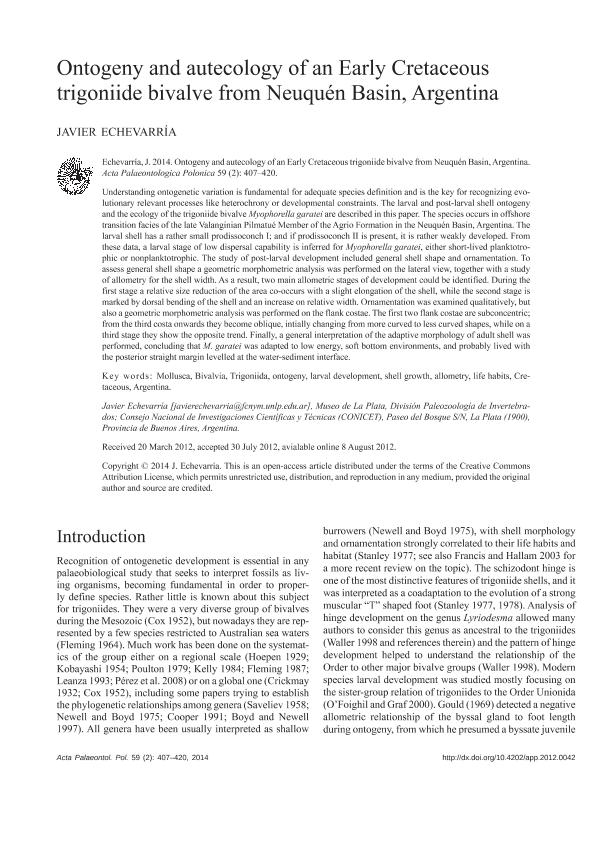Artículo
Ontogeny and autecology of an Early Cretaceous trigoniide bivalve from Neuquén Basin, Argentina
Fecha de publicación:
06/2014
Editorial:
Polish Academy of Sciences. Institute of Paleobiology
Revista:
Acta Palaeontologica Polonica
ISSN:
0567-7920
e-ISSN:
1732-2421
Idioma:
Inglés
Tipo de recurso:
Artículo publicado
Clasificación temática:
Resumen
Understanding ontogenetic variation is fundamental for adequate species definition and is the key for recognizing evolutionary relevant processes like heterochrony or developmental constraints. The larval and post-larval shell ontogeny and the ecology of the trigoniide bivalve Myophorella garatei are described in this paper. The species occurs in offshore transition facies of the late Valanginian Pilmatué Member of the Agrio Formation in the Neuquén Basin, Argentina. The larval shell has a rather small prodissoconch I; and if prodissoconch II is present, it is rather weakly developed. From these data, a larval stage of low dispersal capability is inferred for Myophorella garatei, either short-lived planktotrophic or nonplanktotrophic. The study of post-larval development included general shell shape and ornamentation. To assess general shell shape a geometric morphometric analysis was performed on the lateral view, together with a study of allometry for the shell width. As a result, two main allometric stages of development could be identified. During the first stage a relative size reduction of the area co-occurs with a slight elongation of the shell, while the second stage is marked by dorsal bending of the shell and an increase on relative width. Ornamentation was examined qualitatively, but also a geometric morphometric analysis was performed on the flank costae. The first two flank costae are subconcentric; from the third costa onwards they become oblique, intially changing from more curved to less curved shapes, while on a third stage they show the opposite trend. Finally, a general interpretation of the adaptive morphology of adult shell was performed, concluding that M. garatei was adapted to low energy, soft bottom environments, and probably lived with the posterior straight margin levelled at the water-sediment interface.
Archivos asociados
Licencia
Identificadores
Colecciones
Articulos(CCT - LA PLATA)
Articulos de CTRO.CIENTIFICO TECNOL.CONICET - LA PLATA
Articulos de CTRO.CIENTIFICO TECNOL.CONICET - LA PLATA
Citación
Ontogeny and autecology of an Early Cretaceous trigoniide bivalve from Neuquén Basin, Argentina; Polish Academy of Sciences. Institute of Paleobiology; Acta Palaeontologica Polonica; 59; 2; 6-2014; 407-420
Compartir
Altmétricas




